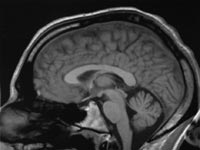This is a repost from the old Wordpress incarnation of Not Exactly Rocket Science
![]() You are being hunted, chased through a labyrinth by a relentless predator. Do you consider your options and plan the best possible escape, or do you switch off and rely solely on instinct? A new study provides the answer - you do both, flicking from one to the other depending on how far away the threat is.
You are being hunted, chased through a labyrinth by a relentless predator. Do you consider your options and plan the best possible escape, or do you switch off and rely solely on instinct? A new study provides the answer - you do both, flicking from one to the other depending on how far away the threat is.
 Earlier studies have found that different parts of a rodent's brain are activated in the face of danger, depending on how imminent that danger is. Now, scientists at University College London has found the same thing in human brains.
Earlier studies have found that different parts of a rodent's brain are activated in the face of danger, depending on how imminent that danger is. Now, scientists at University College London has found the same thing in human brains.
It would be a poor strategy to stick to the same defensive behaviours in all situations. Simply put, there are threats and there are threats, and we need different kinds of behaviour to cope with different scales of danger. When a predator is fifty feet away, we have the time and space to consider our options and plan an escape. But when it's five feet away, such luxuries are ill-afforded and behaviour needs to be fast and reflexive. In the millisecond between life and death, the best laid plans of mice and men take a back seat in the light of three simple options - fight, flight or freeze.
This sounds fairly obvious, but Dean Mobbs and colleagues actually watched the switch taking place by scanning the brains of several volunteers as they were being chased by a predator. Of course, ethics committees would frown on letting a bear loose on some volunteers, so the experiment was done in a virtual Pacman-like game, where people had to flee a virtual predator through a maze. But they weren't completely let off the hook; if they were caught, they received an electric shock.
 Using a scanning technique called functional magnetic resonance imaging, Mobbs saw that when the predator was far away, the subjects showed strong activity in the prefrontal cortex (PFC). This part of the brain sits behind the forehead and is involved in planning complex behaviours, among other things. Mobbs believes that at this point, the PFC is comparing several different strategies of avoiding the threat. In particular, they saw high activity in the ventromedial prefrontal cortex (vmPFC), a region involved in processing risk and fear.
Using a scanning technique called functional magnetic resonance imaging, Mobbs saw that when the predator was far away, the subjects showed strong activity in the prefrontal cortex (PFC). This part of the brain sits behind the forehead and is involved in planning complex behaviours, among other things. Mobbs believes that at this point, the PFC is comparing several different strategies of avoiding the threat. In particular, they saw high activity in the ventromedial prefrontal cortex (vmPFC), a region involved in processing risk and fear.
But as the predator closed in, the activity shifted to different area called the periaqueductal gray (PAG). Located deep inside the brain, the PAG is a much more ancient region than the prefrontal cortex, and controls simpler, more primitive responses - it's the fight-or-flight centre of the brain.
If the PAG is triggered in rats, the animals heart rate and blood pressure go up and they either freeze or run. Mobbs thinks the same thing essentially happens in humans. With death (or shock) fast approaching, the PAG shuts off the brain's complex higher functions, and primes it for a fast, instinctive response.
A gaining predator even triggers different parts of the amygdala, the brain's emotional control centre. When it's far away, the basolateral amygdala lit up - this region connects directly to the PFC and helps to assess the level of the threat. As the predator neared, the action shifted to the amygdala's central nucleus, which connects to the PAG and helps to enact defensive responses.
 This shift from planning to impulse was that much stronger when the threat of pain was higher. If the volunteers were told they were to receive stronger shocks, their PFCs were activated to a lesser extent, while their PAGs showed higher activity.
This shift from planning to impulse was that much stronger when the threat of pain was higher. If the volunteers were told they were to receive stronger shocks, their PFCs were activated to a lesser extent, while their PAGs showed higher activity.
The switch between the calculating PFC and the impulsive PAG may have saved countless of human lives over the course of history. But Mobbs thinks it might cause others some problems. When this careful system goes haywire, it could mean that people misjudge the severity of potential threats, and switch to instinctive mode too easily. These malfunctions may lie behind anxiety attacks and panic disorders.
Reference: Mobbs, Petrovis, Marchant, Hassabis, Weiskopf, Seymour, Dolan & Frith. 2007. Science 317: 1079-1083.
More on the neuroscience of danger:




Isn't that the essence of PTSD? The former threat which was real and immediate gets locked in so that it never recedes and anything reminiscent of it triggers the same immediacy. And therapy for it aims to bring back the prefrontal cortext function.
I like that word "cortext". We need a compelling definition for it, so it will stick.